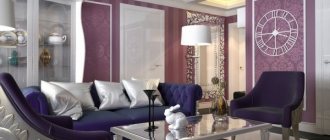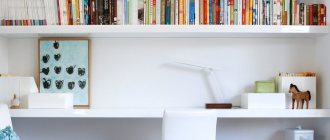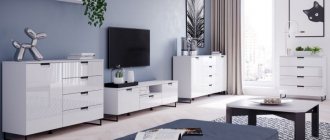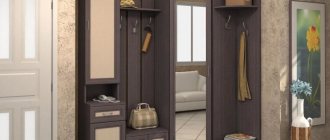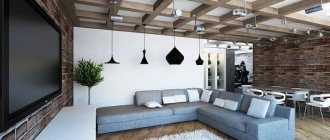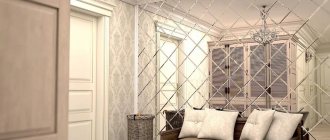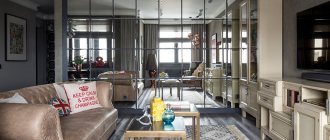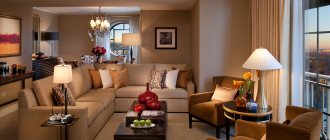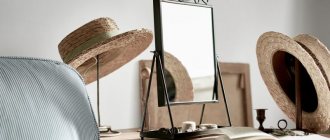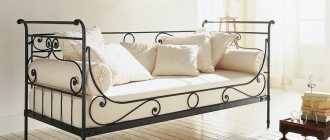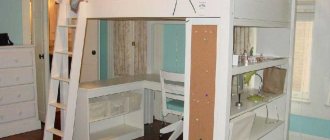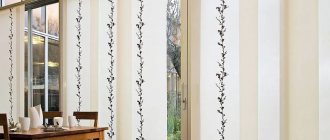Glass in the interior of an apartment or private house is not only stylish, but also multifunctional. Everyone is already accustomed to glass interiors of commercial real estate (showcases, doors, shelves, etc.), but it is still difficult to imagine such structures at home. Most people associate glass with fragility and transparency, so sitting on a glass chair or walking on a glass floor at a height of several meters from the floor is psychologically difficult. But glass accessories are still present in almost every interior, just not in large quantities and without the use of any extravagant solutions. Glass will add volume, space and light to the room. Glass partitions, coffee tables or entire sculptures look unusual and very stylish. They fit into any interior style.
Advantages of glass in the interior
The advantages of using glass elements in a modern interior are obvious. Most often, tempered glass, which is highly durable, is used for interior decoration. It may or may not be transparent. The structure of this material allows you to design or decorate it in different ways. Glass items look sophisticated, expensive and elegant. They are fully in line with fashion trends. Glass does not have its own separate history, which allows it to fit into any interior projects. Glass accessories also look good in high-tech and Provence style. They are appropriate if only because each room already has an object made of glass - a window. That is, this material will not look out of place even in the most unimaginable interior. A competent designer will always find a use for it.
Chemical method
The chemical method of artistic decoration allows you to create a pattern of varying depth and complexity, as well as give a shade from slightly matte to deep opaque matte. It is considered the most labor-intensive and expensive decoration method.
The etching (or matting) method involves applying special pastes containing hydrofluoric acid to the glass surface, which reacts with silicon dioxide, the main component of glass, and destroys its surface, thereby creating a pattern.
Photo: Wardrobe decor using chemical etching
Etching is a rather lengthy and expensive process, especially multilayer etching. Chemical decoration, performed by etching in one step, that is, using one stencil and without applying a protective coating to the glass, is one of the simplest methods of etching. Etching, performed in several layers (multi-layer), is a long and complex process. Its essence is that laminated glass is etched to different depths, thereby achieving the effect of a watercolor image. Moreover, a protective coating is applied to the glass with a wax composition that does not allow acid to pass through. Multilayer etching allows you to achieve the most relief and three-dimensional image of the design.
Photo: Glass decor by etching
Glass and style
The use of glass is typical for any interior, but there are some styles that especially “love” this material. These include the classic style, which is made more elegant and lighter with the help of glass parts. Glass is also appropriate in eco-style, because... it does not emit harmful substances, has an absolutely natural composition and is perfectly combined with wood or stone. Glass elements in combination with strict chrome elements actually form high-tech interiors, which is why glass is the base material for it. The use of glass in industrial interiors allows you to correctly place accents without burdening the room with unnecessary dark partitions. And, of course, kitsch would not be complete without stained glass windows. It is a mixture of all styles, colors and materials, so glass is extremely appropriate here.
Glass color and texture
Color scheme and texture are closely related to each other. Choosing one without the other is illogical. How can you decide on the shade of an object without knowing its curves, features of light reflection and texture? Texture is the properties of the surface, depending on the processing and individual characteristics of the material. Traditionally, texture is determined by the type of surface: matte, glossy or shiny. It is the latter type of texture that is characteristic of glass. The ability to play with the texture of the material is important when only one color is used in the interior, making the space more vibrant and stylish. The color of the glass is also influenced by the style of the interior. If necessary, glass structures can be painted in any color (blue, gold, black) or any design suitable in style can be depicted on their surface:
- flowers;
- sea;
- youth motifs (sneakers, roller skates, torn jeans, etc.);
- mountains;
- abstract objects, etc.
Balconies and windows
Large windows are a dream. They give a lot of light and space to the room. And if you add a beautiful view from the window, you will want to get rid of the walls altogether.
With Russian winters, a wall-to-wall window can lead to huge heating bills. Few will do this. In addition, in apartment buildings it is difficult to obtain permission and increase the window opening. There is a solution - balconies and loggias. They can be completely glazed. And make the exit to the balcony panoramic. If you are interested in this idea, this article
will be useful to you.
Glass structures
Translucent structures decorate almost all houses and apartments today. They give the interior originality and airiness. Such products are not only beautiful, but also practical. Their functionality is ensured by the excellent physical characteristics of tempered glass or triplex. They visually enlarge the space and fill it with light. Glass structures are convenient to use. They are very difficult to break, but easy to wash. Modern innovative technologies make it possible to apply special protective films to glass, thanks to which dust and dirt will simply bounce off the material. All glass structures are manufactured in special production conditions. Moreover, this applies to both ready-made interior items and those that were made to order, taking into account the characteristics of the room.
Doors
Glass doors can complement the interior of two adjacent rooms or a corridor, which makes their installation as practical as possible. These designs are ideal for small rooms because... visually enlarge the space, letting light into it. Moreover, this also applies to doors made of opaque glass. In any case, it has better light transmittance than wood. Most often, interior doors are made of glass, not exterior doors. These structures are made of tempered glass or triplex. They are safe and durable. Even if the door is broken, the resulting fragments will not harm people or animals due to their streamlined shape. Since glass doors look quite simple, they are often decorated with unusual patterns or entire graphic images. As for the type of mechanism, glass doors are divided into:
- sliding;
- swing;
- radius;
- rotary;
- sliding;
- pendulum.
Partitions
Glass partitions often replace traditional walls, but have wider functionality. They are divided into all-glass, frame (including those designed like French glazing) or block. In most cases, glass partitions are made stationary in order to effectively isolate part of the room. Also, stationary glass partitions are found in bathrooms, where they provide waterproofing, making the room visually spacious. Mobile glass partitions can be moved if necessary. Due to this, it is possible to use the same room in different ways without disturbing the design project. This option is ideal for spacious kitchens connected to living rooms, or for bedrooms that also serve as a study. Glass partitions can be:
- sliding;
- radius;
- pendulum;
- foldable.
Stairs and railings
Stairs and glass railings are typical for private houses. In city houses, of course, there are two-story apartments, but not in such large numbers. Glass stairs with railings allow you to visually save space thanks to surfaces that reflect light, and make the massive structure light and airy. But their appearance is deceptive: such stairs can withstand heavy loads thanks to the latest technologies. If the budget allows, then for the manufacture of stairs we use bent glass, the shape of which can be changed in every possible way, adapting to the design project of the room. But triplex and tempered glass are also distinguished by their high strength characteristics. When making sheets for steps, the manufacturer always takes into account that the top layer will be subject to heavy loads, so special protective substances are applied to it.
All sheets for steps are treated with a special agent that glues them tightly together, preventing broken particles from scattering.
Floors
Glass floors look futuristic and interesting in modern interiors. They use special tempered laminated glass or multilayer triplex. These floors are very durable, they can withstand loads of up to 400 kg, and are also resistant to shock, moisture and abrasion. The glass floor is durable and soundproof. Its physical properties remain unchanged even in the event of sudden temperature fluctuations. To eliminate the possibility of slipping on the glass surface, it is made rough. To create the desired atmosphere, it is not at all necessary to make the entire floor in the room from glass; it is enough to highlight only a certain area. Glass allows you to play interestingly with the lighting of the room: spotlights can be built into such a floor, giving the room an unusual ambiance.
Mechanical method of decoration
The mechanical method of decoration allows you to make a design, ornament or inscription on glass using an abrasive material by removing glass particles from the surface and, thereby, making the glass matte. This method includes engraving, grinding and sandblasting.
Sandblasting has now gained the greatest popularity with the development of technological capabilities. The essence of this technology is that a pre-prepared pattern with slots is glued onto the glass, which is subject to the action of abrasive materials. They form microscopic chips on the surface of the glass at an arbitrary angle to it, which gives a matte, opaque tint to the glass. Thus, using several templates at the same time that cover a design or ornament in different ways can create a relief image. The sandblasting method is used mainly for decorating glass partitions in offices, bathrooms and showers, wardrobes and doors, and store windows.
Photo: Sandblasting three-dimensional drawing
The engraving process can be performed physically using laser engraving and ultrasonic engraving.
Photo: Example of laser engraving
Glass furniture
Glass furniture in the interior of an apartment or house looks stylish and impressive. Over time, this fragile material became durable and safe, which made it possible to decorate kitchen units with it and make unique all-glass furniture for home and office (for example, glass cabinets). Almost every modern home has dining and coffee tables made of glass, but today there are also chairs, sideboards, shelves, and even beds made of glass. Although such furniture is not suitable for everyone. Psychologically, it is very difficult to decide to lie down on a glass bed, although it is not inferior in strength to a wooden one. Families with children and pets can even buy such furniture. It will withstand absolutely all mechanical loads. Glass furniture of standard and unusual shapes fits perfectly into technological and urban interiors. It creates a feeling of empty space and looks elegant.
Practical solutions
As you already understand, manufacturers make furniture only from durable materials. One of these is tempered glass. Where is furniture made from such durable glass usually used? – in the bedroom, living room, bathroom, kitchen.
The material is quite durable, you can't just break it. And if this does happen, then you don’t have to worry that the furniture will crumble, because the glass is covered with a thick film that will preserve the appearance of the furniture.
A practical solution would be a closet with a full-length mirror. It’s convenient when you can see yourself in full growth.
If there are small children in the family, then choose glass furniture with rounded edges so as not to lead to bad consequences.
Now about what material the legs should be made of. It can be either forged metal or figured wood. Such materials are considered the most durable, so choose and don’t doubt it.
Decorative elements
Decorative elements made of glass will be appropriate even if there are no other glass objects in the room. The type and color of accessories depends on the overall style of the interior. Elegant glass figurines will look stylish next to metal decorative items. Artificial and fresh flowers look great in glass vases of any size. Custom globes, candlesticks and boxes are made from glass. Unusual dishes (dishes, glasses of interesting shapes and large vessels for various purposes) and paintings made of glass can serve as interior decoration. Small translucent accessories will complement any design. But these elements can also serve a practical function. For example, from time to time the dish can be used to serve a hot second dish on the table, and sometimes you can drink good wine from glasses. Moreover, it is better to purchase these accessories in stores or markets, and not in online catalogues.
The use of glass in the interior of rooms
Glass can find its use in almost every room. The exception is the children's room. Still, for the convenience of children and the peace of mind of adults, it is better not to place furniture or glass doors in the children's room. Very young children are learning about the world, so they may decide to break a glass object to see what is inside, and teenagers may rebel against a transparent glass door. But for other rooms, glass interior items are a real find. Specific details are selected depending on the functional purpose of each room and the existing design project. You need to try to ensure that each glass element matches the style of a particular room and the overall design solution for the entire apartment. But modern ideas make it possible to assemble glass objects of different textures and colors.
In the living room
The possibilities for using glass in the living room are endless and depend only on the wishes of the homeowners. You can make a stylish suspended ceiling in the room from glass with a matte or mirror surface. The lamps built into this ceiling will create a feeling of comfort and tranquility. Also in living rooms, glass ceilings and partitions are appropriate. Moreover, the texture and color of the material can be any. Stained glass partitions and doors look impressive, but they are not suitable for every design style. And, of course, you can put glass furniture in the living room: a coffee table, chairs, a sideboard or a small glass cube instead of an ottoman. Glass allows you to play with lighting. You should take advantage of this when designing the living room interior and install lamps in the most unimaginable places in the room: in an aquarium, on the floor, inside a glass partition and even under the seat of a glass chair.
In the kitchen
All-glass kitchen sets are produced only to order and are quite rare. They are not entirely convenient to use, since food is often prepared in the kitchen in the oven and on the stove. Constant heating to high temperatures does not go well with glass furniture. It is better to use this material to make an elegant apron for the kitchen. Moreover, modern technologies make it possible to place a television screen behind this apron. That is, this detail will save free space in the kitchen. But glass can simply be decorated with stylish images using photo printing or sandblasting. You can also place a glass dining table with the same chairs here. This furniture looks impressive, is easy to clean and does not deform due to any mechanical loads. Glass elements can enhance any kitchen.
In bathroom
The bathroom is ideal for decorating with glass. In small and dark bathrooms, you can install doors made of opaque glass. This will make the room brighter. It is with a glass partition (stationary or mobile) that it is most convenient to zone a combined bathroom. At the same time, the glass can be not only transparent, but also colored or frosted, but this will still make the bathroom light. By the way, it is in the bathroom that you can try out a new product – smart glass. This innovative material is interesting because it can turn dark at the right moments without losing its ability to transmit light. But you can also install glass furniture and translucent showers in bathrooms. In any bathroom, glass will look spectacular next to tiles, an acrylic bathtub, and chrome or gold-plated taps.
In the bedroom
The bedroom should be the coziest place in the apartment, so it is best to choose warm shades and details to decorate it. The use of bare, untreated glass makes the interior cold, so in the bedroom it should be adjacent to other materials: brick, stone, wood, etc. Without consulting a designer, it is better not to use too many glass parts in the bedroom. They are not appropriate in all interiors. The same applies to a glass bed. Installing such furniture is quite a bold step. A glass bed may not fit into the interior and will only violate the design concept. In ordinary apartments, it is better to limit yourself to glass accessories: figurines, vases, paintings, etc. Also in the bedroom, doors and windows with multi-colored stained glass will look impressive.
The bedroom should not be overloaded with details. A large amount of glass furniture does not make this room airy, but, on the contrary, makes it heavier.
Which room is it suitable for?
Glass furniture looks good in any room. It can be placed:
- in the living room;
- in the bedroom;
- in the hall;
- in the nursery (for kids it is better to choose furniture from other materials, but for an older child a cabinet or shelf with glass elements is quite suitable);
- in the bathroom.
Glass goes well with other materials, for example, metal (chromed, painted, matte), wood, plastic. Furniture with glass elements is well suited for zoning a room: it allows sunlight to pass through, does not look too bulky, unlike, for example, completely wooden products, and at the same time divides the space into zones.
